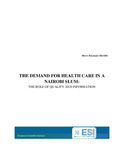| dc.description.abstract | Although studies have previously been done in Kenya on health care demand, it has hitherto not
been clear how health seeking behavior due to illness is affected by information on health care
quality, and by quality variation conditional on this information. Improvement in service quality
without updating the information households hold on quality, will have little or no impact on
health care demand. Moreover, despite in-depth studies on health seeking behavior in Kenyan
rural areas, similar studies in urban areas are missing. There are no econometric studies on
health care demand in slums. Further, it is important for planners and health professionals to
know the covariates that patients believe wrongly or rightly to be the determinants of service
quality as these factors can inform policies aimed at increasing service utilization in slums.
This study develops and tests the hypothesis that the information available about service quality
at a health facility affects demand for health care. The concern is that if the effect of such
information is not taken into account, the estimated health care demand parameters are biased
and can mislead health policy making. The demand parameters reported in this thesis are
estimated using several discrete choice models to ascertain their robustness. The data used were
collected through household and facility surveys from Kibera in Nairobi, one of the largest and
poorest Kenyan slums.
The key finding is that service quality, information about this quality, household wealth, user
fees, and gender, are some of the main determinants of patients' choice among alternative
medical treatments. Simulation results show that health care demand at public clinics elastically
responds to changes in user fees, but demand at any health facility in the formal sector is price
inelastic, as the mean elasticity is less than unity. However own elasticities at public clinics
indicate that a modest increase in user fees at these clinics would drive patients to self-treatment
alternatives, where service quality is uncertain. Moreover, the overall price elasticity suggests
that an increase in the cost of care in general would ceteris peribus lead households to consume
health care at the expense of other necessities. These findings suggest the need to implement
health care pricing policies that ensure that basic health services available in slums are affordable
by the poor. Also recommended, is a policy of regularly extending information about the range
and quality of health services available in public clinics as a means of improving health in slums. | en |

